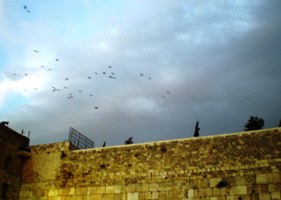“Even the sparrow has found a home and the swallow a nest for herself in which to set her young, near Your altar.” Psalms 84:4
 Having lived in Jerusalem for close to 25 years, I have received invitations to attend many different kinds of celebrations at the Western Wall. They have tended to be fairly traditional in nature, such as bar or bat mitzvahs, tefillin laying ceremonies (the first time a boy puts on phylacteries), “upshers” (the ceremony where at the age of three a Jewish boy has his first hair cut), swearing in parades of various military units and welcoming of new immigrants. However, when my friend Fiona sent me an invitation to a ceremony welcoming back the Common Swifts to Jerusalem, my interest was piqued. How would the birds know when the ceremony was? Would they attend? And what was all this fuss about a few birds anyway? It seemed a little wacky even for Jerusalem where just about any excuse to have a ritual celebration is acceptable.
Having lived in Jerusalem for close to 25 years, I have received invitations to attend many different kinds of celebrations at the Western Wall. They have tended to be fairly traditional in nature, such as bar or bat mitzvahs, tefillin laying ceremonies (the first time a boy puts on phylacteries), “upshers” (the ceremony where at the age of three a Jewish boy has his first hair cut), swearing in parades of various military units and welcoming of new immigrants. However, when my friend Fiona sent me an invitation to a ceremony welcoming back the Common Swifts to Jerusalem, my interest was piqued. How would the birds know when the ceremony was? Would they attend? And what was all this fuss about a few birds anyway? It seemed a little wacky even for Jerusalem where just about any excuse to have a ritual celebration is acceptable.
So, armed with a healthy dose of cynicism, I duly made my way to the Old City event to see what it was all about.
As both our mayor Nir Barkat and deputy mayor Naomi Tsur, were in attendance, I realized that perhaps this was a more significant occasion than I had imagined. There was even a smattering of overseas visitors who had come to Jerusalem especially for the occasion. These were members of Urbis, who are a group interested in promoting biodiversity and sustainable tourism. I found it somewhat touching that the feathered residents of the city were garnering such a star studded line-up.
The story begins more than 50 years ago, when Uriel Safriel, who was then a 16 year old boy, and is today Professor of Ecology at the Hebrew University, noticed the swifts coming to nest in the crevices of the Western Wall. He began to keep a diary of when their migration path brought them to Jerusalem and discovered they were creatures of habit as they returned to their nests on almost exactly the same date over a ten year period.
They spend most of the year living in South Africa and in the springtime migrate north in order to breed. Israel is apparently one of their favourite destinations. Once the chicks have fledged, they head back to African climes at the beginning of June.
 They have an interesting lifestyle as most of their time is spent on the move, as their feet are not built for walking or hopping from branch to branch. They eat, drink, sleep and even mate while flying. According to Dr. Yossi Leshem, of Tel Aviv University, who has been involved in bird research for the past 38 years, it takes the chicks about three months to develop the necessary muscles to enable them to take on such a strenuous way of life and they even engage in a bird version of press ups in order to build up their strength. However, once they take off they can fly at over 100 kilometres an hour. Apparently special light weight sensors have been attached to their backs to chart their progress and map their flight path.
They have an interesting lifestyle as most of their time is spent on the move, as their feet are not built for walking or hopping from branch to branch. They eat, drink, sleep and even mate while flying. According to Dr. Yossi Leshem, of Tel Aviv University, who has been involved in bird research for the past 38 years, it takes the chicks about three months to develop the necessary muscles to enable them to take on such a strenuous way of life and they even engage in a bird version of press ups in order to build up their strength. However, once they take off they can fly at over 100 kilometres an hour. Apparently special light weight sensors have been attached to their backs to chart their progress and map their flight path.
Like the swallows mentioned by King David in my opening quotation, the swifts also chose to make their home near G-d’s dwelling place in Jerusalem. It appears they like old structures in which to build their nests and as the Western Wall is close to 2000 years old, having been built by King Herod as part of the structural renovations he made to the Temple, it certainly fits the bill. Apparently there are 88 such nests in the wall and these were recorded by the researcher Mr Ulrich Tigges and the late Professor Heinrich Mendelsson in 2002 and are shown in blue on the picture below.

During the recent work cleaning the Western Wall and restoring the gates and walls of the Old City (apparently there are more nests in Zion Gate as well as various other places) this study map served as a guideline, to ensure that none of the nests were blocked up.
Because of their strange physiology, the birds need to be able to fly straight into their nests and the holes in the stones in the Western Wall seem to suit their requirements.
Despite the strenuous efforts taken by the municipality of Jerusalem to ensure the swifts continue to visit the city, apparently not all places are so considerate and there is considerable worry as to their continued survival.
The Friends of the Swifts Association, the Society for the Protection of Nature in Israel, and Tel Aviv University are working together to ensure the future of the Common Swift by all available means: saving existing nesting sites, designing and building new ones, facilitating special educational programs in schools, assisting wildlife rehabilitation centers, and creating PR activities to increase public awareness of this special bird and the problems it faces.
 One of the more interesting suggestions made at the ceremony, by Dr Yossi Leshem, is the potential for these winged creatures to be the harbingers of peace and cooperation between the three major monotheistic religions: Judaism, Christianity and Islam. Because of their predilection for old buildings, as well as building their nests in the Western Wall, they have also found the Church of the Nativity in Bethlehem and ancient structures in Jordan suitable places to call home. The hope is that by encouraging all these places to work together for a common cause devoid of politics, the birds may succeed in bringing the sides closer together far more successfully than the politicians.
One of the more interesting suggestions made at the ceremony, by Dr Yossi Leshem, is the potential for these winged creatures to be the harbingers of peace and cooperation between the three major monotheistic religions: Judaism, Christianity and Islam. Because of their predilection for old buildings, as well as building their nests in the Western Wall, they have also found the Church of the Nativity in Bethlehem and ancient structures in Jordan suitable places to call home. The hope is that by encouraging all these places to work together for a common cause devoid of politics, the birds may succeed in bringing the sides closer together far more successfully than the politicians.
In Jewish mysticism, birds are one of the symbols used to herald in the messianic age. Maybe by doing our utmost to make the swifts feel welcome, Jerusalem is pioneering a new diplomatic approach to creating goodwill and harmony amongst men. So if you find yourself in the vicinity around this time next year, drop me a line and I’ll aim to ensure that you too can participate in this unique ceremony!

Brilliant blog! I’m really glad I schlepped you there! I posted it both on my Facebook wall and that of “Green Jerusalem”, which we have created for Naomi Tsur. Birds of a feather…
Delightful – it’s tit-bits (if you will excuse the pun) like this which add such flavour to your tours